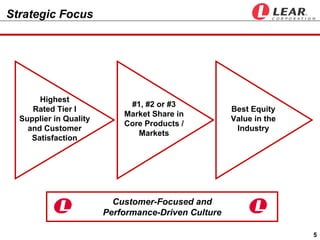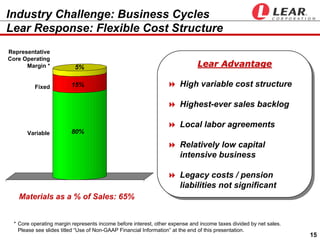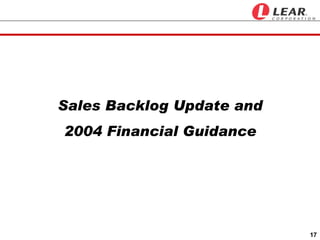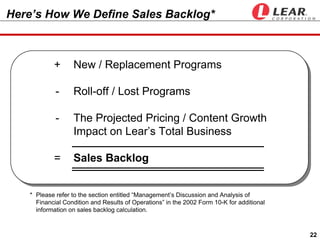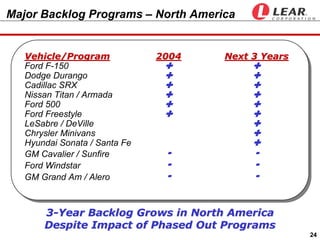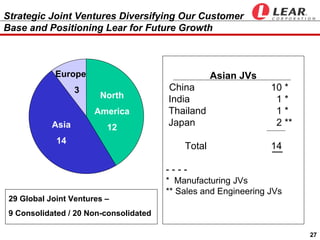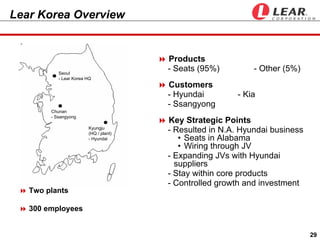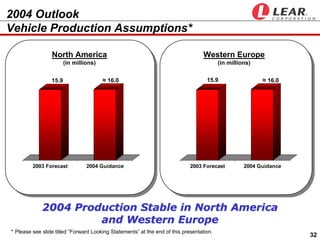LEAR 2004 detroitautoconference
- 1. R AANY Detroit Automotive Conference January 8, 2004 fast forward world’s leading automotive interior supplier advance relentlessly
- 2. “This is Lear” Video (5:00 minutes) 2
- 3. Agenda I. Strategic Overview I. Strategic Overview Bob Rossiter, Chairman & CEO Bob Rossiter, Chairman & CEO II. Industry Challenges II. Industry Challenges Jim Vandenberghe, Vice Chairman Jim Vandenberghe, Vice Chairman III. Sales Backlog Update and III. Sales Backlog Update and 2004 Financial Guidance 2004 Financial Guidance Dave Wajsgras, SVP & CFO Dave Wajsgras, SVP & CFO IV. Panel Q & A Session IV. Panel Q & A Session 3
- 4. Strategic Overview 4
- 5. Strategic Focus Highest #1, #2 or #3 Rated Tier I Best Equity Market Share in Supplier in Quality Value in the Core Products / and Customer Industry Markets Satisfaction Customer-Focused and Performance-Driven Culture 5
- 6. Regional Business Strategy North America Outlook Quality continues to improve Leverage our leadership Sales growing position in total interiors Ensuring competitive footprint Europe Improving operating structure Improve our business structure Low-cost country strategy and grow our market share Growing seats, electronics and cockpits Asia/Asian OEMs Aggressively expand our Top priority presence with Asian OEMs Fastest growing part of our business Partnering With Our Customers to Pursue Profitable Growth Worldwide 6
- 7. 2003 Highlights Internal quality improved 27%; received quality and service Internal quality improved 27%; received quality and service awards from all our major customers awards from all our major customers Ranked as America’s ‘Most Admired’ Company in the Ranked as America’s ‘Most Admired’ Company in the Motor Vehicle Parts Industry by Fortune® Magazine Motor Vehicle Parts Industry by Fortune® Magazine Record net sales, solid earnings growth and strong Record net sales, solid earnings growth and strong cash flow cash flow Investment grade credit rating from S&P and Fitch Investment grade credit rating from S&P and Fitch Initiated quarterly dividend of $0.20 per share Initiated quarterly dividend of $0.20 per share Lear Continues to Deliver Superior Value to Our Customers and Shareholders 7
- 8. Highlights of Today’s Presentation Customer-focused strategy driving our success Customer-focused strategy driving our success Lear is well positioned to meet industry challenges Lear is well positioned to meet industry challenges Sales backlog supports continued growth Sales backlog supports continued growth 2004 outlook reflects record net sales, record 2004 outlook reflects record net sales, record earnings and strong cash flow earnings and strong cash flow Maintaining our Momentum Amid a Highly Competitive Environment 8
- 9. Industry Challenges 9
- 10. Automotive Industry Challenges Global Overcapacity // Slow Growth in Demand Global Overcapacity Slow Growth in Demand Continuous Quality Improvement Continuous Quality Improvement Profitability Under Pressure Profitability Under Pressure Manage Through Business Cycles Manage Through Business Cycles Financial Results in Europe Financial Results in Europe Industry Environment Remains Difficult in North America and Western Europe 10
- 11. Industry Challenge: Slow Growth Lear Response: Profitable Growth Strategy Interiors are the fastest growing automotive segment Interiors are the fastest growing automotive segment Intense focus on improving interiors by all major Intense focus on improving interiors by all major automakers automakers Lear’s sales backlog supports ≈ 5% annual growth Lear’s sales backlog supports ≈ 5% annual growth Growth potential with Asian OEMs, electronics and Growth potential with Asian OEMs, electronics and instrument panels //cockpits instrument panels cockpits Industry’s first Total Interior Integrator program Industry’s first Total Interior Integrator program New product innovation (e.g., IntelliTireTM)) New product innovation (e.g., IntelliTireTM Lear is Well Positioned in the Fastest Growing Segment in the Automotive Industry 11
- 12. Industry Challenge: Quality Lear Response: Quality First Initiative Parts Per Million (PPM) Defective* Management priority Management priority 27 % Imp rov e me Global focus nt Global focus Part of Lear culture Part of Lear culture Six Sigma discipline Six Sigma discipline Sharing best practices Sharing best practices Teamwork Teamwork Nine Months 2002 Nine Months 2003 Driven to Provide the Highest Level Quality Products and Services in the Automotive Industry * Based on internal and customer data. 12
- 13. Industry Challenge: Quality Lear Response: Continuous Improvement Things Gone Wrong (TGW) Lear’s 2003 J.D. Power per 100 vehicles Results C ont i nuo u s Im prove ment 11% improvement in 2003 10.3 9.5 8.3 7.9 4th consecutive year of 7.0 improvement in TGW Highest quality seat manufacturer that supplies multiple OEMs 1999 2000 2001 2002 2003 Source: 2003 J.D. Power Seat Survey Independent J.D. Power Survey Shows Continuous Improvement in Lear’s TGW 13
- 14. Industry Challenge: Profitability Lear Response: Deliver High Value-Added Outstanding customer relationships Outstanding customer relationships Total interior capability Total interior capability True partner vs. supplier True partner vs. supplier Economies of scale // common architecture Economies of scale common architecture Aggressive VA // VE initiatives Aggressive VA VE initiatives Ongoing quality and cost efficiencies Ongoing quality and cost efficiencies Lear Works in Partnership with Customers to Eliminate Waste and Add Value 14
- 15. Industry Challenge: Business Cycles Lear Response: Flexible Cost Structure Representative Core Operating Lear Advantage Lear Advantage Margin * 5% High variable cost structure 15% High variable cost structure Fixed Highest-ever sales backlog Highest-ever sales backlog Local labor agreements Local labor agreements 80% Variable Relatively low capital Relatively low capital intensive business intensive business Legacy costs / /pension Legacy costs pension liabilities not significant liabilities not significant Materials as a % of Sales: 65% * Core operating margin represents income before interest, other expense and income taxes divided by net sales. Please see slides titled “Use of Non-GAAP Financial Information” at the end of this presentation. 15
- 16. Industry Challenge: Europe Lear Response: Improvement Plan in Place Aggressively grow content per vehicle Aggressively grow content per vehicle Grow seats, electronics and cockpits Grow seats, electronics and cockpits Source to low cost countries Source to low cost countries Improve overall business structure Improve overall business structure Intense focus on quality and delivery Intense focus on quality and delivery In a Challenging Environment, We are Steadily Improving our Results in Europe 16
- 17. Sales Backlog Update and 2004 Financial Guidance 17
- 18. Competitive Strengths Deliver Superior Value Customer & Shareholder Value High Quality Customer Satisfaction LEVERAGE Improving Financials Strong Cash Flow STRENGTHS re ultu ly ’ C s tles n R e le ce van ‘A d Total DELIVER Automotive Competitive Strengths VALUE Interior Customer Focus Capability Operational Excellence Economies of Scale Innovation 18
- 19. Financial Priorities We are focused on: We are focused on: Profitable growth Profitable growth Improving ROIC Improving ROIC Generating cash Generating cash Financial discipline Financial discipline Meeting Our Commitments and Delivering Shareholder Value 19
- 20. Focused Strategy has Supported Rapid Growth for Lear Net Sales ome (in billions) t I nc % $15.5 Ne 20 $16.0 $14.4 AGR $14.1 $13.6 C $14.0 $12.4 SALES $12.0 CAGR $9.1 $10.0 20% $7.3 $8.0 $6.2 $4.7 $6.0 $3.1 $4.0 $2.0 $0.0 1994 1995 1996 1997 1998 1999 2000 2001 2002 2003 Guidance Net sales have steadily No strategic hole in Lear’s increased since IPO to about product line up $15.5 billion today Lear ranks 131 among the Fortune 500 and is the 16th 17 major acquisitions during the 1990’s fastest growing company in the U.S. over the last ten years 60% acquisition growth 40% organic growth 20
- 21. Going Forward, Strong Revenue Growth Continues $1,250 $1,000 $900 $750 Sales Backlog (in millions) $500 2004 2005 2006 2007 2008 $4,400 $3,900 $750 Cumulative $2,000 $3,000 3-Year and 5-Year Sales Backlog Increases to Highest-Ever Absolute Levels 21 * Please see slide titled “Forward Looking Statements” at the end of this presentation.
- 22. Here’s How We Define Sales Backlog* + New / Replacement Programs - Roll-off / Lost Programs - The Projected Pricing / Content Growth Impact on Lear’s Total Business = Sales Backlog * Please refer to the section entitled “Management’s Discussion and Analysis of Financial Condition and Results of Operations” in the 2002 Form 10-K for additional information on sales backlog calculation. 22
- 23. Sales Backlog Assumptions Industry Production* Change from Prior North America - 16 million No Change Western Europe - 16 million No Change South America - 1.9 million No Change Asia Pacific - Program Specific No Change Currency - $1.20 / Euro Stronger Euro * Assumes J.D. Power and Associates market share projections Trend Industry Production Projected to be Flat; Euro Continues to Strengthen 23
- 24. Major Backlog Programs – North America Vehicle/Program 2004 Next 3 Years Ford F-150 Dodge Durango Cadillac SRX Nissan Titan / Armada Ford 500 Ford Freestyle LeSabre / DeVille Chrysler Minivans Hyundai Sonata / Santa Fe GM Cavalier / Sunfire Ford Windstar GM Grand Am / Alero 3-Year Backlog Grows in North America Despite Impact of Phased Out Programs 24
- 25. Major Backlog Programs – International Vehicle/Program 2004 Next 3 Years Peugeot 407 Volvo S80 / V70 Ford Focus C-Max Peugeot 107 Mazda Familia Hyundai Terracon Volvo S40 / V50 Citroen C6 Toyota / PSA Sub-B Backlog for International Operations Strong, Reflecting Key New Product Launches 25
- 26. Sales Backlog Highlights Key assumptions and overall composition Key assumptions and overall composition essentially unchanged essentially unchanged Strict ROIC discipline on all new awards Strict ROIC discipline on all new awards Continued customer, product and geographic Continued customer, product and geographic diversification: diversification: -- Asian and European customers represent nearly Asian and European customers represent nearly half of all new business half of all new business -- IPs and cockpits represent about one-quarter of IPs and cockpits represent about one-quarter of the backlog the backlog Sales Backlog Continues to Represent Customer, Product and Geographic Diversification 26
- 27. Strategic Joint Ventures Diversifying Our Customer Base and Positioning Lear for Future Growth Europe Asian JVs China 10 * 3 North India 1* Thailand 1* America Japan 2 ** Asia 12 14 Total 14 ---- * Manufacturing JVs ** Sales and Engineering JVs 29 Global Joint Ventures – 9 Consolidated / 20 Non-consolidated 27
- 28. Lear China Overview Wuhan (2) Products - Citroen - Renault/Nissan - Seats - Door Panels - Wiring - Carpet/Acoustics Shiyan / Xiangfan - Nissan Customers Shenyang Nanjing - CBA-BMW - Fiat - Jiangling (Ford) - ChangAn (Ford) Chongqing - ChangAn, Suzuki - SAIC (GM) - FAW (Audi) Shanghai (3) - Ford - SGM, SVW - Nanjing - Iveco (Fiat) - DFM (Nissan, PSA) - China Brilliance (BMW) - Others Nanchang - Isuzu, Suzuki, Ford Key Strategic Points - Follow customers’ footprint - Potential manufacturing for export Ten Joint Ventures - Leverage partners’ resources for technology • Lower technology risk 4,000 employees - Controlled growth and investment 28
- 29. Lear Korea Overview Products - Seats (95%) - Other (5%) Seoul - Lear Korea HQ Customers - Hyundai - Kia - Ssangyong Chunan - Ssangyong Key Strategic Points - Resulted in N.A. Hyundai business Kyungju (HQ / plant) • Seats in Alabama - Hyundai • Wiring through JV - Expanding JVs with Hyundai suppliers - Stay within core products - Controlled growth and investment Two plants 300 employees 29
- 30. Return on Invested Capital Improving Trailing Twelve Month ROIC* 11.0% 10.6% 10.5% 9.8% 10.0% 9.5% 9.0% 8.5% 8.5% 8.0% 1Q 2Q 3Q 4Q 1Q 2Q 3Q 4Q 1Q 2Q 3Q 2001 2001 2001 2001 2002 2002 2002 2002 2003 2003 2003 * Return on Invested Capital (ROIC) represents income before restructuring charges, amortization, interest, other expense and income taxes times (1 - effective tax rate) divided by average invested capital. Average invested capital is the sum of total assets, sold accounts receivable and the present value of operating leases (assuming a discount rate of 10%) less the sum of accounts payable and drafts and accrued liabilities, based on the account values on the last day of the prior four quarters. Please see slides titled “Use of Non-GAAP Financial Information” at the end of this presentation. 30
- 31. Strong Free Cash Flow Generation Cumulative Free Cash Flow* $2,000 (in millions) $1,700 $1,500 $1,301 $907 $1,000 $589 $500 $179 $0 1999 2000 2001 2002 2003 * Net Debt to Cap 70 % 65 % 63 % 58 % < 50 % * Free cash flow represents net cash provided by operating activities before the net change in sold accounts receivable, less capital expenditures. Net debt represents total debt plus utilization of our ABS facility, less cash. Please see slides titled “Use of Non-GAAP Financial Information” at the end of this presentation. 31
- 32. 2004 Outlook Vehicle Production Assumptions* North America Western Europe (in millions) (in millions) 15.9 ≈ 16.0 ≈ 16.0 15.9 2003 Forecast 2004 Guidance 2003 Forecast 2004 Guidance 2004 Production Stable in North America and Western Europe * Please see slide titled “Forward Looking Statements” at the end of this presentation. 32
- 33. 2004 Outlook Net Sales* (in billions) ≈ $16.2 2004 Guidance ≈ $15.5 2003 Guidance $14.4 2002 Record Net Sales in 2004 Anticipated * Please see slide titled “Forward Looking Statements” at the end of this presentation. 33
- 34. 2004 Outlook Net Income Per Share** $6.25 $5.85 $5.50 $5.40 $4.65 * Approx. 2002 2003 Guidance 2004 Guidance Effective Tax Rate 33.5% 29.0% 28.0% Record Net Income Per Share Anticipated * Represents income per share before cumulative effect of a change in accounting principle, which excludes the impact of goodwill impairment of $298.5m after-tax, or $4.46 per share. 34 **Please see slide titled “Forward Looking Statements” at the end of this presentation.
- 35. 2004 Outlook Capital Spending* ≈ $350 ≈ $315 (in millions) $273 2002 2003 Guidance 2004 Guidance Depreciation $301 ≈ $325 ≈ $370 Capital Spending Increases to Fund Major New Program Launches * Please see slide titled “Forward Looking Statements” at the end of this presentation. 35
- 36. 2004 Outlook Free Cash Flow* (in millions) ≈ $400 ≈ $400 $395 2002 2003 Guidance 2004 Guidance Interest Expense $211 ≈ $190 ≈ $175 Free Cash Flow Remains Strong * Please see slides titled “Use of Non-GAAP Financial Information” and “Forward Looking Statements” at the end of this 36 presentation.
- 37. Summary ‘Quality First’ Initiative driving continuous process ‘Quality First’ Initiative driving continuous process and quality improvements and quality improvements Lear is well positioned for profitable growth with Lear is well positioned for profitable growth with highest ever sales backlog and improving highest ever sales backlog and improving operating fundamentals operating fundamentals Key financial metrics improving: Key financial metrics improving: Strong net income per share growth Strong net income per share growth Continuing strong free cash flow Continuing strong free cash flow Solid and improving capital structure Solid and improving capital structure Strong Momentum to Continue in 2004 and Accelerate in 2005 37
- 38. R ADVANCE RELENTLESSLY™ LEA Listed www.lear.com NYSE
- 39. Use of Non-GAAP Financial Information In addition to the results reported in accordance with accounting principles generally accepted in the United States (“GAAP”) included throughout this presentation, the Company has provided information regarding certain non-GAAP financial measures. These measures include “core operating margin,” “free cash flow,” “ROIC” and “net debt.” Core operating margin represents income before interest, other expense and income taxes divided by net sales. Free cash flow represents net cash provided by operating activities before the net change in sold accounts receivable, less capital expenditures. The Company believes it is appropriate to exclude the net change in sold accounts receivable in the calculation of free cash flow since the sale of receivables may be viewed as a substitute for borrowing activity. ROIC represents income before restructuring charges, amortization, interest, other expense and income taxes times (1 - effective tax rate) divided by average invested capital. Average invested capital is the sum of total assets, sold accounts receivable and the present value of operating leases (assuming a discount rate of 10%) less the sum of accounts payable and drafts and accrued liabilities, based on the account values on the last day of the prior four quarters. Net debt represents total debt plus utilization under its ABS facility, less cash. Management believes that the non-GAAP financial measures used in this presentation are useful to both management and investors in their analysis of the Company’s financial position and results of operations. In particular management believes that core operating margin is a useful measure in assessing the Company’s financial performance by excluding certain items that are not indicative of the Company’s continuing operating activities or that may obscure trends useful in evaluating the Company’s continuing operating activities. Management believes that free cash flow is useful in analyzing the Company’s ability to service and repay its debt. Management believes that ROIC is a commonly used measure that provides useful information regarding the efficiency with which the Company’s assets are deployed. Management believes that net debt is generally accepted as providing useful information regarding a company’s financial condition. Further, management uses these non-GAAP measures for planning and forecasting in future periods. Neither core operating margin, free cash flow, ROIC nor net debt should be considered in isolation or as substitutes for net income, net cash provided by operating activities, total debt or other balance sheet, income statement or cash flow statement data prepared in accordance with GAAP or as measures of profitability or liquidity. In addition, the calculation of free cash flow does not reflect cash used to service debt and thus, does not reflect funds available for investment or other discretionary uses. Also, these non-GAAP financial measures, as determined and presented by the Company, may not be comparable to related or similarly titled measures reported by other companies. Set forth on the following slides are reconciliations of these non-GAAP financial measures to the most directly comparable financial measures calculated and presented in accordance with GAAP. 39
- 40. Use of Non-GAAP Financial Information Free Cash Flow (in millions) Twelve Months 2002 2001 2000 1999 Free cash flow Net cash provided by operating activities $ 545.1 $ 829.8 $ 753.1 $ 560.3 Net change in sold accounts receivable 122.2 ( 245.0 ) ( 21.2 ) 10.4 Net cash provided by operating activities before net change in sold accounts receivable 667.3 584.8 731.9 570.7 Capital expenditures ( 272.6 ) ( 267.0 ) ( 322.3 ) ( 391.4 ) Free cash flow $ 394.7 $ 317.8 $ 409.6 $ 179.3 40
- 41. Use of Non-GAAP Financial Information Return on Invested Capital Earnings Twelve Months (in millions) Q3 2003 Q4 2001 Q1 2001 Income before restructuring charges, amortization, interest, other expense and income taxes Income before income taxes $ 528.9 $ 89.9 $ 395.9 Restructuring charges - 159.3 4.2 Amortization - 90.2 90.1 Interest expense 196.0 254.7 313.9 Other expense, net 58.6 85.8 44.1 Income before restructuring charges, amortization, interest, other expense and income taxes $ 783.5 $ 679.9 $ 848.2 (return on invested capital earnings) 41
- 42. Use of Non-GAAP Financial Information Net Debt (in millions) December 31, Net debt 2002 2001 2000 1999 Short term borrowings $ 37.3 $ 63.2 $ 72.4 $ 103.6 Current portion of long-term debt 3.9 129.5 155.6 63.6 Long-term debt 2,132.8 2,293.9 2,852.1 3,324.8 Total debt 2,174.0 2,486.6 3,080.1 3,492.0 Cash ( 91.7 ) ( 87.6 ) ( 98.8 ) (106.9 ) Asset backed securitization 189.0 260.7 - - Net debt $ 2,271.3 $ 2,659.7 $ 2,981.3 $ 3,385.1 Note: Net Debt to Cap is defined as Net Debt divided by Net Debt plus Stockholder’s Equity. 42
- 43. Forward-Looking Statements This presentation contains forward-looking statements within the meaning of the Private Securities Litigation Reform Act of 1995, including statements regarding anticipated financial results. Actual results may differ materially from anticipated results as a result of certain risks and uncertainties, including but not limited to general economic conditions in the markets in which the Company operates, including changes in interest rates and fuel prices, fluctuations in the production of vehicles for which the Company is a supplier, labor disputes involving the Company or its significant customers or that otherwise affect the Company, the Company’s ability to achieve cost reductions that offset or exceed customer-mandated selling price reductions, the impact and timing of program launch costs, costs associated with facility closures or similar actions, increases in warranty costs, risks associated with conducting business in foreign countries, fluctuations in currency exchange rates, adverse changes in economic conditions or political instability in the jurisdictions in which the Company operates, competitive conditions impacting the Company’s key customers, raw material cost and availability, the outcome of legal proceedings, unanticipated changes in free cash flow and other risks detailed from time to time in the Company’s Securities and Exchange Commission filings. These forward-looking statements are made as of the date hereof, and the Company does not assume any obligation to update them. 43




